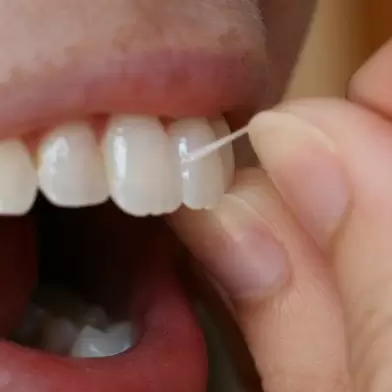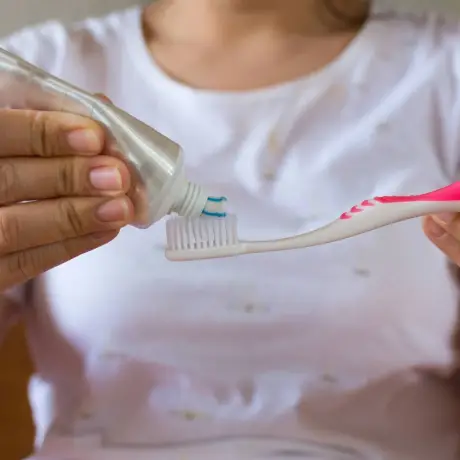Tooth brushing / the use of dental floss
WHY IS THE USE OF DENTAL FLOSS NECESSARY?
The first symptoms of gingivitis appear on the gum line and in the interdentium. Daily flossing is an important part of daily dental care since it helps to remove plaque from areas which are hard to reach by a toothbrush. However, flossing has its own technique, which is expedient to learn.
THE CORRECT TECHNIQUE OF FLOSSING
Since we put our hand in our mouth when flossing, first of all we should was our hands thoroughly! The American Dental Hygienists’ Association summarizes the key elements of the dental flossing technique in four simple steps:
Tearing off: Tear off a piece of dental floss of about 30 to 40 centimetres, twist it around the middle or index finger of one hand (left or right), then also a shorter piece around the middle or index finger of your other hand. (If someone twists it around his/her middle finger, then they will be able to freely move the dental floss with their index finger.) Although this may seem too long at first, but you need a greater amount of dental floss to make sure that there is enough for each interdentium. Stretch a 3 to 5 cm section of dental floss between your index finger and thumb. Direct the floss with your thumb into the upper interdentia.
Leading in: Hold a 3 to 5 cm dental floss section tightened between your finger and thumb. Lead the dental floss with your two index fingers into the lower interdentia.
Sliding: Direct the dental floss in the interdental areas with careful zig-zag movements. Be careful that the dental floss does not burst or „jump” out of the interdentium! Push the dental floss in an arch on the side of the tooth so that the thread surrounds the tooth in a C shape.
Moving: Move the dental floss pushed onto the surface of the tooth up and down, penetrating under the gum line as well. Do not forget about the back of the tooth either! Every time you move onto another tooth, roll down another clean section from the thread twisted around your middle finger, and at the same time twist the used section around the middle finger of your other hand. Prop the thread against your thumb! Be careful not to hurt your gums. Don’t give up even if you find the use of dental floss cumbersome in the beginning, you will be able to apply it better after some practice. If you can’t manage to use the dental floss, ask for advice from your dental hygienist.
This technique can be used with any kind of dental floss, whether it is waxed, non-waxed, spongy or dental ribbon.
You can choose the dental floss to your liking, all you have to do is keep to the right technique. You can select from many different types according to your and your family members’ needs.
It doesn’t matter whether you start flossing the upper or lower teeth or from the front or the back. Just make sure that you go through all interdental areas on the right and left side, on the upper and lower part of the mouth as well as on the back of the very last teeth.
EVERYONE ELSE
Every mouth, every tooth and every interdentium is different. This means that ideal oral hygiene needs to be determined in relation to individual anatomical conditions, age and capabilities. Ask for advice and training from your dental hygienist. Perfect, efficient and at the same time gentle tooth-cleaning cannot be learnt from books.
THE USE OF DENTAL FLOSS WITH A HANDLE
The technique of the operation in case of dental floss with a handle is similar. Hold the handle tight and tilt the head towards the surface you want to floss first (either the lower or the upper teeth). Carefully slide the dental floss in between to teeth and take care that the dental floss does not burst or jump out. Apply the same zig-zag movement as in the case of the standard dental floss. Push the dental floss in an arch on the surface of the each tooth, sliding it under the gum line as well and go through all the surfaces of the teeth.
THE USE OF DENTAL FLOSS AROUND BRACES
If you wear braces or a similar device, in order to avoid the wire arches and brackets, it is especially important to use te correct flossing technique. You can also use a special dental floss, the rigid end of which can be threaded under the centre arch of the braces.

A beautiful smile is the best investment!
Book an appointment for an oral hygiene treatment now!
GENTLE USE
Since the inappropriate use of dental floss can lead to injuries, you must take care of being thorough and forbearing at the same time, especially during the use of an electric dental floss. You may experience some gum bleeding when flossing at the start, but this has to stop soon. If there is still bleeding after a few days when using a dental floss, it could be a sign of gum disease. It is important to discuss this with your dentist or dental hygienist, who can check whether your gums are healthy and can give you advice on how to alleviate the problem.
HOW OFTEN DO YOU NEED TO USE A DENTAL FLOSS?
Many people are puzzled about how often they need to use a dental floss or whether they need to use it before or after tooth brushing. It is worth starting to use an interdental brush or dental floss in order to clean the interdentium once a day before brushing your teeth in the evening.


